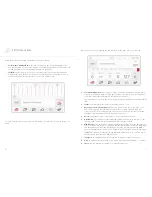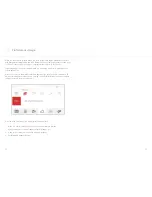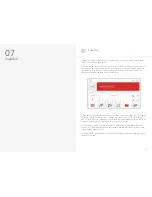
28
29
LFO’s
Modal 002R features two individual low frequency oscillators: LFO1 is a simple LFO and is
‘global’ across the patch (so it affects the whole sound); LFO2 has more parameters and is
applied ‘per voice’ (so it affects each note/voice individually). Both LFO1 and LFO2 have these
parameters:
1. Waveform:
Allows you to choose one among the four available LFO waveforms (i.e. sine,
sawtooth, square and sample & hold).
2. Rate:
This parameter controls the speed of the LFO.
3. MIDI Sync:
This parameter syncs the speed of the LFO to either the internal or an
external MIDI clock. The clock source can be selected within the ‘MIDI Settings’ page.
When enabled the ‘Rate’ parameter changes to show divisions of a typical 4/4 bar, so 1/4
would be a crotchet, 1/2 would be a minim etc.
LFO2 has these additional parameters:
4. Delay:
This parameter controls the initial delay of the LFO. The LFO is initially silent, then
it’s amplitude increases until it reaches its full amplitude and keeps constant: ‘Delay’
regulates the time needed to complete this initial phase.
5. Note:
This parameter controls the amount of the keytracking modulation on the LFO
speed: at positive values, the higher the note you press, the faster the LFO runs.
6. Sngl:
This button switches between the LFO’s different modes:
Reset
: in this mode, each new keypress restarts the LFO and it the continues to run -
particularly useful for Unison/Stack sounds
Freerun:
in this mode LFO2 is never reset, so it could be at any phase when a note is
pressed
Reset + Single:
in this mode, LFO2 will start when a new key is pressed, do one cycle
and stop, but when a new note comes in and one is already playing, LFO2 is retriggered
Single:
in this mode, LFO2 will start when a new key is pressed, do one cycle and stop,
but will not retrigger when a new note comes in and one is already held (like in Mono/
Unison key modes)
7. Speed Hi / Low:
when this parameter is set to “High”, LFO2 runs at 3 times the speed
of “Low” mode.
8. Bi / Uni polar mode:
if Unipolar, the LFO will outcome only positive modultion values,
while Bipolar is a more common negative-positive. Particularly useful for the Square
waveform.
Note that LFO1 is slower than LFO2, allowing modulations that are impossible to do with
LFO2, more suitable for pad/ambient sound design.






























